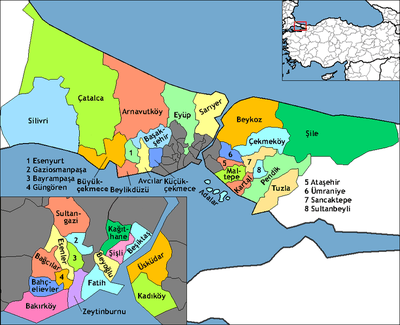Büyükçekmece
Büyükçekmece is a district and municipality (belediye) in the suburbs of Istanbul, Turkey on the Sea of Marmara coast of the European side, west of the city. It is largely an industrial area with a population of 380,000. The mayor is Hasan Akgün (CHP).
Büyükçekmece | |
|---|---|
district | |
.jpg) The district of Büyükçekmece | |
 Location of Büyükçekmece in Istanbul | |
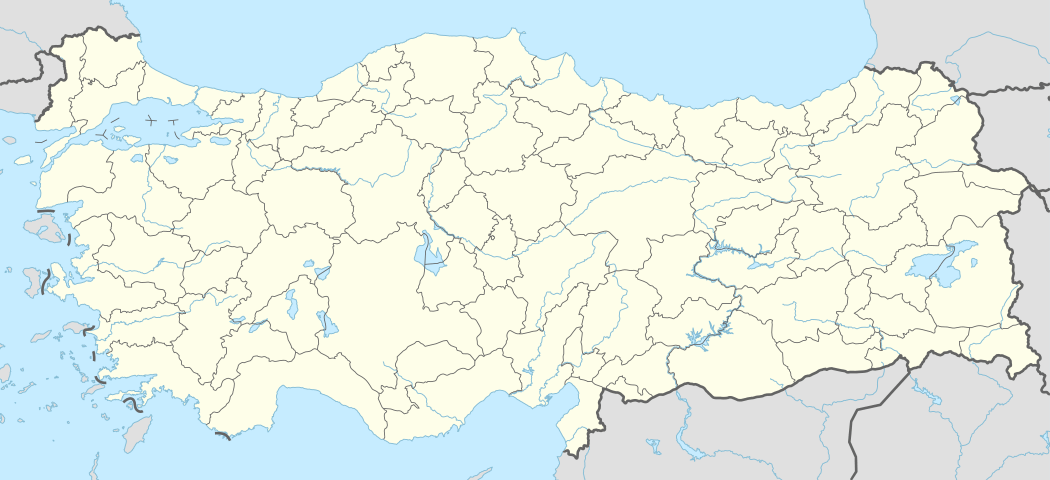 Büyükçekmece Location of Büyükçekmece in Istanbul | |
| Coordinates: 41°01′12″N 28°34′39″E | |
| Country | Turkey |
| City | Istanbul |
| Government | |
| • Mayor | Hasan Akgün (CHP) |
| • Governor | Ismail Gündüz |
| Area | |
| • District | 239.25 km2 (92.37 sq mi) |
| Population (2012)[2] | |
| • District | 201,077 |
| • District density | 840/km2 (2,200/sq mi) |
| Time zone | UTC+2 (EET) |
| • Summer (DST) | UTC+3 (EEST) |
| Postal Code | 34537 |
| Area code(s) | 0-212 |
| Website | www |
History
The land around this inlet of the Sea of Marmara, has been settled, abandoned and resettled throughout history as army after army passed along the coast to the Bosphorus. It is thought to be the site of the Greek colony on the Marmara shore called Athyra (Άθυρα), also known as Athyras.
In 443 AD, the armies of Attila the Hun took this settlement and its associated fort, and this was presumably his last conquest of that campaign before turning around.
The earliest mention of the bishopric of Athyra in a list of dioceses is of the late 15th century, but a seal has been found of a 10th-century Bishop Orestes of the see. No longer a residential bishopric, Athyra is today listed by the Catholic Church as a titular see.[3]
The Ottoman architect Mimar Sinan built a bridge to cross the mouth of the inlet (Lake Büyükçekmece) and there are ruins of inns and caravansarai, which show this was a stopping place on the road to Europe. At the beginning of the Ottoman period, it was empty forest and farmland, and has gradually been settled by Turkish people migrating in from the Balkans and the Caucasus.
According to the Ottoman population statistics of 1914, the kaza of Büyükçekmece had a total population of 13.121, consisting of 9.511 Greeks, 3.255 Muslims, 195 Bulgarians, 143 Roma people and 17 Armenians.[4]
In the early years of the Turkish Republic, it was still very rural, with village cottages, farmland behind, and by the sea the odd weekend home for people of Istanbul. The area was a very popular day or weekend trip from the city, there is a sandy shoreline, a long seafront and until the 1970s families would come out to Büyükçekmece for fishing, crabbing or for a day on the beach.
Büyükçekmece today
The area administered by Büyükçekmece includes a large hinterland behind the Marmara shore, some of it still rural.
Lake Büyükçekmece was connected to the sea until it was separated by a dam to supply fresh water to Istanbul. The Mimar Sinan Bridge is located in this area.[5]
Notable buildings
- Sancaklar Mosque (2012)
Education
- Istanbul International Community School Marmara Campus[6]
- Beykent University Büyükçekmece Campus[7]
Twinned towns
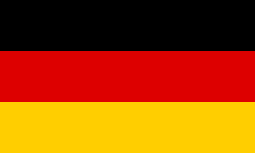
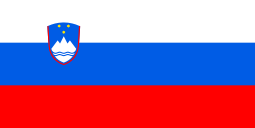
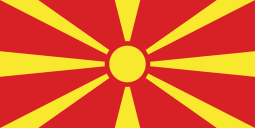
Friendship Cities
See also
References
- "Area of regions (including lakes), km²". Regional Statistics Database. Turkish Statistical Institute. 2002. Retrieved 2013-03-05.
- "Population of province/district centers and towns/villages by districts - 2012". Address Based Population Registration System (ABPRS) Database. Turkish Statistical Institute. Retrieved 2013-02-27.
- Annuario Pontificio 2013 (Libreria Editrice Vaticana 2013 ISBN 978-88-209-9070-1), p. 841
- Kemal Karpat (1985), Ottoman Population, 1830-1914, Demographic and Social Characteristics, The University of Wisconsin Press, p. 184-185
- Mülayim, Selçuk; Akşit, İlhan (2005). Turkish art and architecture in Anatolia & Mimar Sinan. Akşit. p. 135. ISBN 978-975-7039-22-8.
- "Campus Information". Istanbul International Community School. Retrieved 2019-07-09.
- "Iletisim". Beykent University. Retrieved 2019-07-09.
Büyükçekmece Yerleşkesi Cumhuriyet Mahallesi, Beykent, Büyükçekmece / İstanbul
